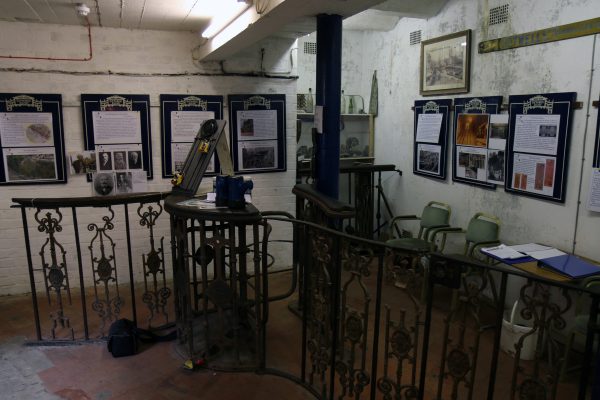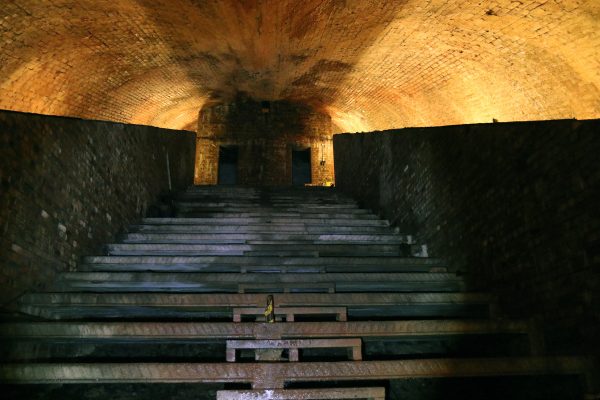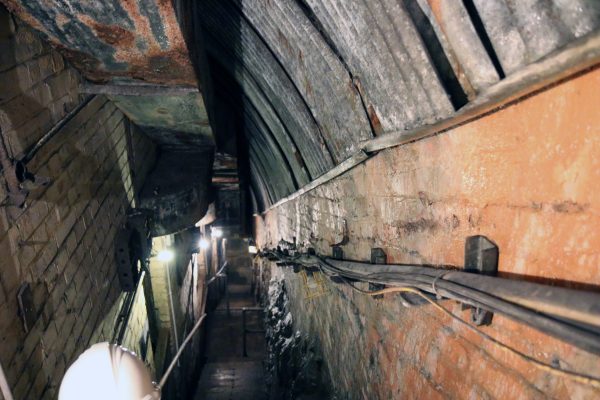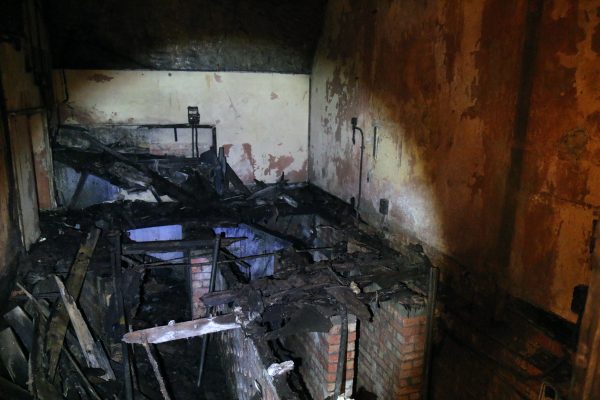Deep under the streets of Bristol lies an abandoned underground railway that served a secret purpose in WW2 and is only now starting to occasionally open its doors to curious visitors.
Opened in 1893, the Clifton Rocks Railway is also a special sort of railway, a funicular, that runs up, and down, a very steep slope, in this case also inside a tunnel dug out of the rock that forms the Avon Gorge.
It offered, or at least intended to offer, a convenient link from the high levels next to the Clifton Suspension Bridge down to the river Avon, some 200 feet below. However, despite a promising start, it was not a commercial success and closed in 1934, then things got secretive.
But back to the railway.
As anyone who has visited the area knows, the river Avon runs through a very steep gorge, and as anyone who has walked up that slope knows, it’s very hard work.
In the 19th century, plans were made for a spa to be opened at the top of the gorge, but the visitors would mainly arrive by boat, and face a steep exhausting climb. Not pleasant today, and far too steep for gentle Victorian ladies.
So, plans were announced for a short railway to run up the slope, but the locals thought it was rather ugly, so a revised plan was announced, to dig a tunnel through the limestone rock and hide the railway.
This was approved, and construction started with what is thought to have been the UK’s first ever use of electric detonation of dynamite to start blasting their way down the cliff face.
Tunelling through the rock was completed in a mere six months, but just as they were about to start fitting out the inside for the railway, there was a rock fall at the bottom of the tunnel.
The tunnel wasn’t structurally in danger, it’s just that the limestone was loose and fearing the risk of stones falling onto railway tracks with fatal consequences, they lined the entire tunnel with an inner skin of bricks.
The 500 foot long tunnel was finally completed in 1893, and when it opened, it was the widest tunnel in the world. Even today, the shallow profile of the excavation impresses engineers who manage to get a visit into the Clifton Rocks Railway tunnels.
There were two stations, one at the bottom with a grand facade facing the river boat piers, and the upper station next to the spa, which is today a large hotel.
The railway had two tracks, and the method of operating them was ingeniously simple. One carriage on each track, linked by a cable that ran in a loop through the railway.
As one carriage descended to the bottom, its weight pulled the other carriage to the top on the other railway track. To ensure that the carriage at the top always weighed more than the one at the bottom, a large water tank was underneath the carriages, and just enough water would be added at the top to make it overcome the weight of the lower carriage.
A signalling system alerted the staff at the top as to how many passengers were at the bottom so they would know how much water was needed. When the trains completed the trip, the spent water was pumped back to the top for reuse.
Over 400,000 people used the railway in its first year, but it was never really much of a commercial success. In 1912 it was sold to the local tram operator, but despite some upgrades, it still didn’t pull in the punters, so it finally closed in 1934.
After the railway closed, it was left empty until WW2, when it became a secret base. Blast walls were installed to protect the tunnel, and then it was used for wartime services.
Some of the upper sections were used by BOAC as a repair factory for barrage balloons, and three sections were turned into air raid shelters, but more significantly, the lower levels were converted into an emergency broadcast station by the BBC.
Although only the relay station was the only part initiated by the BBC, they constructed a local studio should the need arise. The BBC kept the site in standby right up to 1960.
Since then it was used variously for storage by the local hotel, who curiously still own most of the tunnel.
About a decade ago, a local group of volunteers started clearing out decades of rubble, and now, on occasion, tours are offered, which start at the smaller top station, along with obligatory hard hats and jackets.
Although it’s over a 120 years old, and essentially been many things not railway for 80 of those years, there’s still a surprising amount of original station fittings. Although most of the upper station has long been altered to add in extra walls and a blast proof ceiling, there is still a working turnstile in the room.
Standing alone, it’s a curious echo of the early days of the railway and a mystery as to why it was never removed, as the others were. Maybe even in wartime, some sense of heritage existed.
The platform which extends under the main road above is supported by cast iron pillars, and due to the novelty of the railway, a section of roof contained glass bricks to allow sightseers to watch the funicular railway at work.
Peering out through a window in a WW2 installed wall you can still see the slope of the railway, and the bricked off tunnel wall, with a mural of one of the carriages, and only recently uncovered, two of the massive steel wheels that carried the cables.
The railway carriages could carry 18 people each and were originally painted blue and white with gold trim, but later repainted to match the Bristol trams.
Originally, only staff could be expected to walk down the tunnel, but when it was taken over for wartime uses, the tunnel was converted into a series of large rooms, with a concrete staircase running down each side.
Peering through gaps and doors into the rooms still piled up with rubble and junk, dimly lit, or illuminated for those of us with our own torches.
The mystery of what happened to the missing turnstiles upstairs is revealed in the gloom.
Other rooms show evidence of the floors that were inserted to make them usable for repairing barrage balloons, with the floors having long since rotted away. Deep under the rubble, the original railway tracks still remain as there simply wasn’t enough time to remove them. Sections of track being visible through the gaps in the stairs we used.
WW2 banisters, and electricity fittings, and along one side, the supports for the cables carrying radio broadcasts from the studios deep down below to the surface antennas.
Three of the largest spaces were given over to air raid shelters, for those who pre-ordered a ticket. Unlike the workshops above, floors weren’t inserted here, and people sat on steps running down the tunnel.
A large tarpaulin ran between the walls, to stop dirt and dust falling on the heads of those sheltering from the bombs that were shaking the ground above.
The lower two shelters had space for chemical toilets, so presumably the people in the upper room either shared, or crossed their legs.
While the public certainly knew that the air raid shelters were here, what they probably didn’t know was what went on past a gas proof door at the bottom of the shelters.
This was the BBC’s emergency radio studios, to take over if Broadcasting House in London was destroyed.
Much like the workshops near the surface, the tunnel has been converted into a number of rooms, each with floors that are now slowly rotting away. Small trapdoors in the floors connected upper rooms to lower levels, in case the staircase outside was blocked by falling rocks from bomb hits.
It’s said that one of the rooms contained a mini grand piano, but photos taken at the time show that most of them were filled with broadcasting technology rather than recording studios.
Nonetheless, the concrete steps outside are now suddenly replaced with rubber steps, to avoid noisy feet disturbing broadcasts to the nation at time of peril.
Deeper down still we come to the most important section of the BBC facilities… the canteen. Or at least, an empty room that was the canteen.
And down here, the toilets. Such was the hierarchy of life at the times, that while the public sheltered above and used improvised chemical loos, just yards away in the BBC they had plumbing and decent toilets.
Buckets for men and women, but porcelain for ladies and gentlemen.
The funicular railway station also was put into use, for ventilation equipment and power supplies. Getting from one side to the other today requiring a squeeze through a small gap in the wall, but here in the old station entrance, the original wooden paneling is still visible in places.
An upper floor has steel sheets covering some of the walls and there are remnants of the old WW2 air ducting on the floor. The ducting was very visible outside the old station during the war, so people would have known something was there, but wartime secrecy meant people tended not to ask questions, so the BBC’s secret remained safe.
Standing behind the bricked up facade, you can hear the roar of road traffic just feet away.
A number of rather ugly concrete pillars that now sit outside the lower station are a recent addition due to concerns about the stability of the rock in the area.
The difficulty is that you are now at the bottom of a very steep tunnel, and while there is an exit down here, your bags are at the top — so time to climb all the back up those stairs.
Stopping several times — certainly not because you need a break from the climb — but because it affords another chance to see these WW2 relics that have laid here hardly seen by anyone for decades.
Access to the Clifton Rocks Railway tunnel is still quite restricted as the visits are organised by unpaid volunteers.
There will be open days on Sunday May 21st and September 9th and 10th to see the station. If you want to go into the tunnel, then there are longer tours available, and you need to keep an eye on their website for details.
Alternatively, if you can muster at least ten people, then they can sort out a group tour.
Do follow their advice to bring a torch as while there’s enough light to walk around, you’ll miss a lot if you cant point a torch into the dark rooms.


























I had a chance to visit the railway earlier this year with Subterranea Britannica and it was fascinating. There were actually 4 carriages, 2 pairs; one for the spa residents, the other 4 the public as one of the photos we saw showed. The sad thing about that photo though was that it was taken as the rails were being severed and the carriages being destroyed to give room for the BBC studios.
Very cool – thanks for sharing this amazing story.
The railway was originally the work of George Croydon Marks who designed and built a number of cliff railways around the country. The ones at Lynton, Bridgnorth, Aberystwyth and Saltburn are still in use.
Terrific item about a wonderful relic. Many thanks Ian. I visited with Sub Brit some years back and can thoroughly recommend. Get Peter Davey as your guide!
Excellent write up, shows that you were listening to the guides!
The turnstile is in the top station because the volunteers spend a very sweaty Sunday afternoon winching it up the stairs about 10 years ago. The hole in the bomb proof wall was made exactly the correct dimensions to retrieve it. I was one of the lucky souls who had to make the hole with a disc cutter and drills and help to haul it upstairs. There are pictures of this in our Facebook Group and a video somewhere….
Hi,
I am a Master’s student at Newcastle University and I am currently planning a hypothetical art exhibition to take place at Clifton Rocks Railway. I was wondering if you had a map or floor plan of inside the railway station that I could use in order to plan the layout of my exhibition?
Thank you in advance.
Kind regards,
Sophie Stevenson
You would find it quicker to ask the Clifton Rocks Railway for that sort of thing.
I’d love to know the date of the old photo showing the staff at the front of the lower entrance. My grandfather, his brother and their father ran it in the 1890s and 1900s. They also lived very local to it at the Colonnade. The father’s sister-in-law was married to George Marks, the engineer who built the railway.